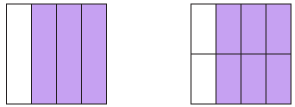![]()
Example 1
Show that \(\dfrac{3}{4}\) and \(\dfrac{6}{8}\) are equivalent fractions using:
- the number line
- squares
Solution
- We divide the number line into lengths of \(\dfrac{1}{4}\) and \(\dfrac{1}{8}\) and observe that \(\dfrac{3}{4}\) and \(\dfrac{6}{8}\) are at the same point on the number line.

Detailed description - The two equal squares below are divided into four and eight equal parts respectively. We can see that \(\dfrac{3}{4}\) is the same area as \(\dfrac{6}{8}\).

Detailed description
Example 2
Fill in the boxes to complete the equivalent fractions:
- \(\dfrac{1}{5}=\dfrac{\Box}{20}=\dfrac{\Box}{25}=\dfrac{\Box}{60}\)
- \(\dfrac{3}{5}=\dfrac{18}{\Box}=\dfrac{\Box}{55}=\dfrac{21}{\Box}\)
Solution
- \begin{align}\dfrac{1}{5}=\dfrac{4}{20}&\hspace{30mm}(5 × 4 = 20\ \text{and}\ 1 × 4 = 4)\\\\ \dfrac{1}{5}=\dfrac{5}{25}&\hspace{30mm}(5 × 5 = 25\ \text{and}\ 1 × 5 = 5)\\\\ \dfrac{1}{5}=\dfrac{12}{60}&\hspace{30mm}(5 × 12 = 60\ \text{and}\ 1 × 12 = 12)\end{align}
-
\begin{align}\dfrac{3}{5}=\dfrac{18}{30}&\hspace{30mm}(3 × 6 = 18\ \text{and}\ 5 × 6 = 30)\\\\ \dfrac{3}{5}=\dfrac{33}{55}&\hspace{30mm}(5 × 11 = 55\ \text{and}\ 3 × 11 = 33)\\\\ \dfrac{3}{5}=\dfrac{21}{35}&\hspace{30mm}(3 × 7 = 21\ \text{and}\ 5 × 7 = 35)\end{align}
Example 3
Simplify \(\dfrac{21}{24}\)
Solution
\(\dfrac{21}{24}=\dfrac{\color{red}{\setminus}\hspace{-4mm}{21^7}}{\color{red}{\setminus}\hspace{-4mm}{24^8}}=\dfrac{7}{8}\)
So the simplest form is \(\dfrac{7}{8}\).




